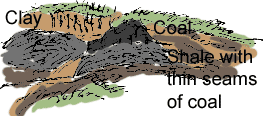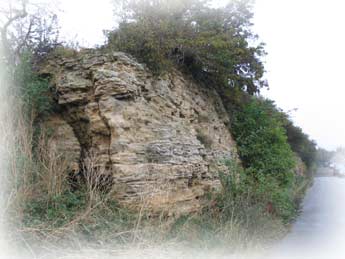
The Magnesian Mystery Tour |
Richard Bell's Wild West Yorkshire nature diary, Saturday, 13th October, 2007 |

 AFTER
A YEAR of planning for our West Yorkshire Geodiversity Action Plan,
it’s
great to be on the road at last, checking out the quarries, rail and road cuttings
which we are hoping to put forward as suitable for educational use.
AFTER
A YEAR of planning for our West Yorkshire Geodiversity Action Plan,
it’s
great to be on the road at last, checking out the quarries, rail and road cuttings
which we are hoping to put forward as suitable for educational use.
The first that we call at, an old coal measures quarry at Flanshaw, (above and left) has possibilities. It can be approached over a grassy public open space and lies between a library and a supermarket. There’s a primary school just around the corner. It’s one of the few places in the Wakefield District where you can see an exposed coal seam. Coal has been so important in the history of the county yet it’s mainly hidden from view. Here's an opportunity to explain the origins of coal to a local audience.

This quarry at Knottingley, by the old town hall (above), wouldn’t be suitable for groups of young children as it is right next to a canal but for older students, the right-angled slice through the magnesian limestone provides an opportunity to get an impression of the true dip of the beds of rock in three dimensions.
The limestone here was so much in demand that, in the 1830s, an Elizabethan manor house was purchased and demolished so that more could be quarried. The canal goes to Goole, so we guess that the flaggy limestone, which would be unsuitable as a building stone (except for drystone walls), was shipped along the coast to Redcar for use in the iron industry. Another possibility is that it was used in lime kilns to provide lime for agriculture and I believe there was a glass industry in the area so perhaps it was used there.
 The
old quarry face along the back of the playing fields of Upton Rugby
Club has much more variety
in the limestone than the flaggy limestone
at Knottingley. I imagine that in the Permian period there was a low mound
of limy mud here, in tropical seas that were shallow enough to allow
algae to grow on its surface and to
The
old quarry face along the back of the playing fields of Upton Rugby
Club has much more variety
in the limestone than the flaggy limestone
at Knottingley. I imagine that in the Permian period there was a low mound
of limy mud here, in tropical seas that were shallow enough to allow
algae to grow on its surface and to  add
to the deposits on the mound with precipitated lime.
We need to do more research to find out exactly what is going on here.
add
to the deposits on the mound with precipitated lime.
We need to do more research to find out exactly what is going on here.
We were lucky enough to call just as a junior match was coming
to a close; a bacon roll and a mug of coffee from the club house made the perfect
mid-morning break on our geological survey!